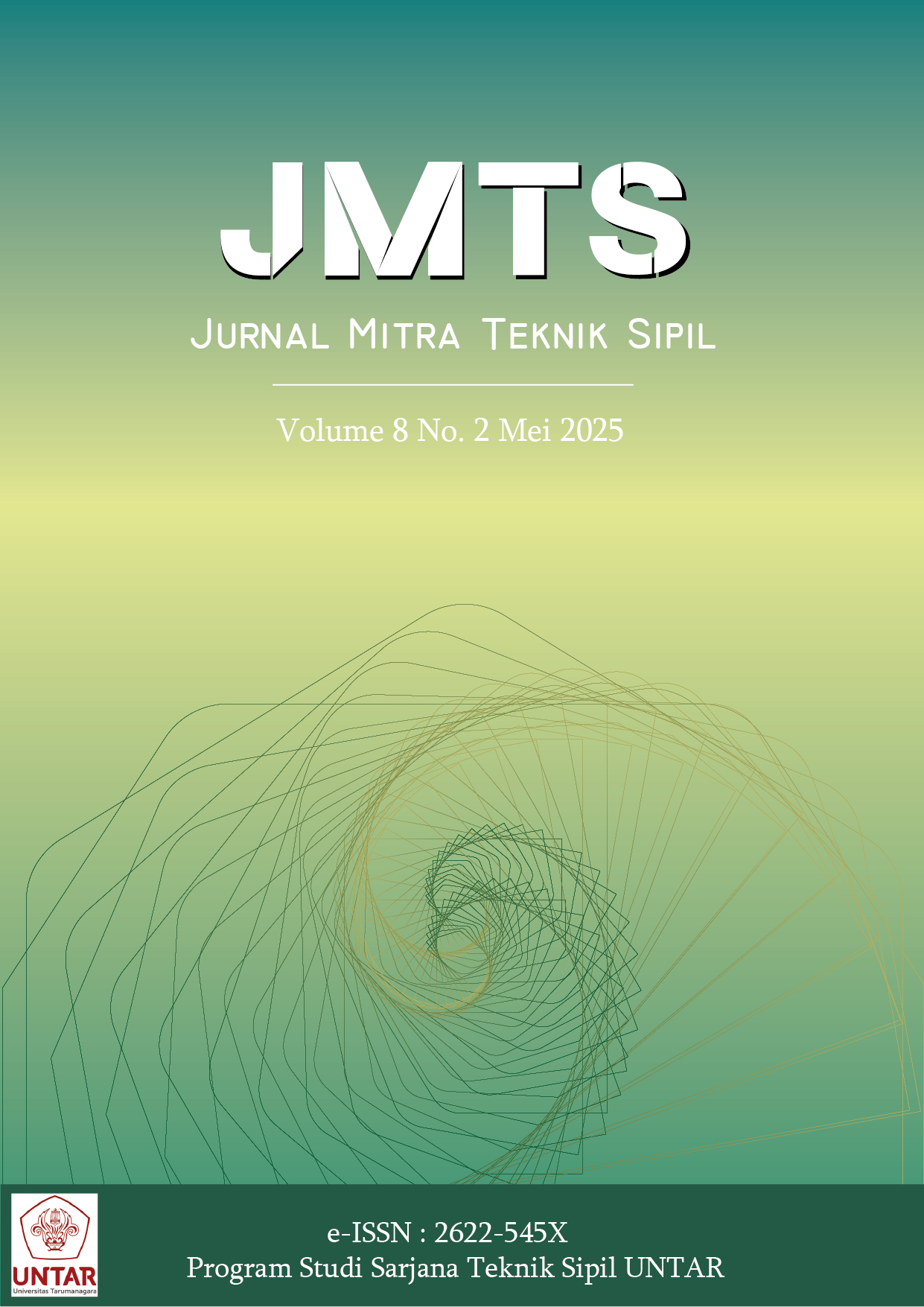PEMANFAATAN LIMBAH PLASTIK POLYETHYLENE THEREPTHALETE (PET) UNTUK CAMPURAN ASPHALT CONCRETE - WEARING COURSE (AC – WC)
Main Article Content
Abstract
This research is an innovation to reduce asphalt use by adding PET plastic waste to the asphalt mixture. The asphalt mix design uses 60/70 pen asphalt with a certain percentage as well as PET waste. The aim of the research is to find out what is the optimal percentage of using PET in the pen 60/70 asphalt mixture to produce an asphalt mixture that meets the criteria or specifications and what are the stability and flow values with this mixed innovation. The use of PET is being considered because this is expected to reduce plastic waste. Apart from that, PET's properties include being strong, water resistant and easy to recycle. It is hoped that it will be able to contribute to the mixture in terms of ease of implementation in the mixture and providing strength to the mixture. The implementation used the experimental method with data taken directly where the aggregate data, the average density of fine and coarse aggregates was 2.7 and 2.6, gradation analysis using a combination of coarse aggregates (CA): medium aggregates (MA): fine aggregates (FA) obtained 19%: 34%: 46%. Asphalt pen 60/70 which meets specifications and PET waste with percentages of 2%, 4%, 6%, 8% and 10%. The test results of the mixture obtained a stability value between 1100 to 1300 kg and a flow value ranging from 3.00 – 3.70.
Abstrak
Penelitian ini merupakan salah satu inovasi untuk mengurangi penggunaan aspal dengan menambahkan limbah plastik PET pada campuran aspal. Desain campuran aspal menggunakan aspal pen 60/70 dengan persentase tertentu begitu juga limbah PET. Tujuan untuk mengetahui berapa persentase optimal penggunaan PET padacampuran aspal pen 60/70 untuk menghasilkan campuran aspal yang memenuhi kriteria atau spesifikasi dan berapa nilai stability dan flow dengan inovasi campuran tersebut. Penggunaan PET dipertimbangkan karena dengan ini diharapkan dapat mengurangi limbah plastic, selain itu sifat yang dimiliki PET antara lain kuat, tahan air dan mudah di daur ulang diharapkan mampu memberikan kemudahan pelaksanaan dalam campuran dan memberikan tambahan kekuatan pada campuran aspal. Pelaksanaan menggunakan metode experiment dengan data yang diambil secara langsung dimana data agregat berat jenis rata – rata agregat halus juga kasar adalah 2,7 dan 2,6, analisa gradasi dengan kombinasi coarse agregates (CA) : agregat medium (MA) : agregat halus (FA) diperoleh 19% : 34% : 46%. Aspal pen 60/70 yang memenuhi spesifikasi dan limbah PET dengan persentase 2%, 4%, 6%, 8% dan 10 %. Hasil uji dari campuran diperoleh nilai stabilitas di antara 1100 sampai 1300 kg dan nilai flow rentang 3,00 – 3,70.
Article Details

This work is licensed under a Creative Commons Attribution-NonCommercial-ShareAlike 4.0 International License.
This work is licensed under Jurnal Mitra Teknik Sipil (JMTS) Creative Commons Attribution-ShareAlike 4.0 International License.References
Badan Standardisasi Nasional. (2008). Metode uji berat jenis dan penyerapan air agregat halus (SNI 1970:2008). http://sispk.bsn.go.id/SNI/DaftarList
Badan Standardisasi Nasional. (2012). Metode uji untuk analisis saringan agregat halus dan agregat kasar (ASTM C 136-06, IDT) (SNI ASTM C136:2012). http://sispk.bsn.go.id/SNI/DaftarList
Badan Standardisasi Nasional. (1991). Metode pengujian campuran aspal dengan alat Marshall (SNI 06-2489-1991). http://sispk.bsn.go.id/SNI/DaftarList
Pinem, H. K. W. B., Pristyawati, T., & Safarizki, H. A. (2022). Analysis of the influence of additional plastic waste (HDPE) as Mixed Asphalt AC-WC on Marshall Parameters. ASTONJADRO, 11(3), 669-679. https://doi.org/10.32832/astonjadro.v11i3.7507
Khadafi, M., & Fadly, I. (2023). Studi penggunaan plastik HDPE (High Density Polyethylene) pada campuran aspal sebagai bahan pengikat kostruksi jalan. Jurnal Karajata Engineering, 3(2), 102-106.
Utomo, L. W., & Arfiana, S. (2023). Pemanfaatan limbah plastik daur ulang dari polietilen tereftalat (PET) sebagai bahan tambahan dalam pembuatan nanokomposit, semen mortar, dan aspal. Jurnal Teknologi Lingkungan Lahan Basah, 11(1), 164-179.
Rahmawati, A. (2015). Pengaruh penggunaan Plastik Polyethylene (PE) dan High Density Polyethylene (HDPE) pada campuran Lataston-WC terhadap karakteristik Marshall. Semesta Teknika, 18(2), 147-159.. https://journal.umy.ac.id/index.php/st/article/view/1816/1820
Simangunsong, J.E. (2021). Pemanfaatan limbah plastik pet sebagai bahan tambah aspal pada campuran Asphalt Concrete Wearing Course (AC-WC). Teknologi Sipil: Jurnal Ilmu Pengetahuan dan Teknologi, 5(2), 26-33.. http://dx.doi.org/10.30872/ts.v5i2.6983



